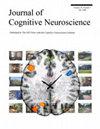内源性注意力会影响与决策相关的神经活动,但不会影响传入视觉反应
IF 3.1
3区 医学
Q2 NEUROSCIENCES
引用次数: 0
摘要
对即将到来的刺激的内源性空间注意力转移与对刺激的行为反应的改善、α功率的视网膜准备性转移以及 ERPs 的变化有关。虽然注意力对几种早期感觉ERP的调节作用已经得到证实,但关于注意力在什么情况下会影响最早的皮层视觉诱发反应--C1 ERP成分--这种反应可能是由初级视觉皮层的传入输入产生的,目前仍存在争议。此外,空间注意对最近发现的证据积累的ERP特征--顶叶中央阳性(CPP)--的影响尚未完全定性。本研究通过一项空间诱导对比度分辨任务来评估空间注意力对 C1 和 CPP 成分的影响,该任务使用的刺激物专门设计用于产生大振幅 C1 反应,并通过感官证据强度的变化来描述 CPP 的特征。在对上视野或下视野进行 80% 有效提示后,受试者会根据两个棋盘式刺激物中哪个对比度更大做出反应。刺激前的α功率会根据提示发生地形变化,这表明参与者会转移注意力,为即将到来的刺激做好准备。尽管α功率发生了这些注意力转移,而且这些刺激引起的 C1 反应比之前的许多研究可靠地高出数倍,但没有证据表明注意力对 C1 有影响。然而,在有效试验中,CPP 的建立率明显增加。我们的研究结果表明,内源性注意力可能不会影响早期的 C1 ERP 成分,但可能会改善决策阶段的行为,这一点反映在与证据积累(CPP)相关的大脑信号中。本文章由计算机程序翻译,如有差异,请以英文原文为准。
Endogenous Attention Affects Decision-related Neural Activity but Not Afferent Visual Responses
Endogenous shifts of spatial attention toward an upcoming stimulus are associated with improvements in behavioral responses to the stimulus, preparatory retinotopic shifts in alpha power, and changes in ERPs. Although attentional modulation of several early sensory ERPs is well established, there is still debate about under what circumstances attention affects the earliest cortical visual evoked response—the C1 ERP component—which is putatively generated from afferent input into primary visual cortex. Moreover, the effects of spatial attention on the recently discovered ERP signature of evidence accumulation—the central parietal positivity (CPP)—have not been fully characterized. The present study assessed the effect of spatial attention on the C1 and CPP components through a spatially cued contrast discrimination task using stimuli that were specifically designed to produce large-amplitude C1 responses and that varied in sensory evidence strength to characterize the CPP. Participants responded according to which of two checkerboard stimuli had greater contrast following an 80% valid cue toward the upper or lower visual field. Prestimulus alpha power changed topographically based on the cue, suggesting participants shifted attention to prepare for the upcoming stimuli. Despite these attentional shifts in alpha power and the fact that the stimuli reliably elicited C1 responses several times greater than many prior studies, there was no evidence of an attention effect on the C1. The CPP, however, showed a clear increase in build-up rate on valid trials. Our findings suggest that endogenous attention may not affect the early C1 ERP component but may improve behavior at a decision stage, as reflected in brain signals related to evidence accumulation (the CPP).
求助全文
通过发布文献求助,成功后即可免费获取论文全文。
去求助
来源期刊
CiteScore
5.30
自引率
3.10%
发文量
151
审稿时长
3-8 weeks
期刊介绍:
Journal of Cognitive Neuroscience investigates brain–behavior interaction and promotes lively interchange among the mind sciences.

 求助内容:
求助内容: 应助结果提醒方式:
应助结果提醒方式:


